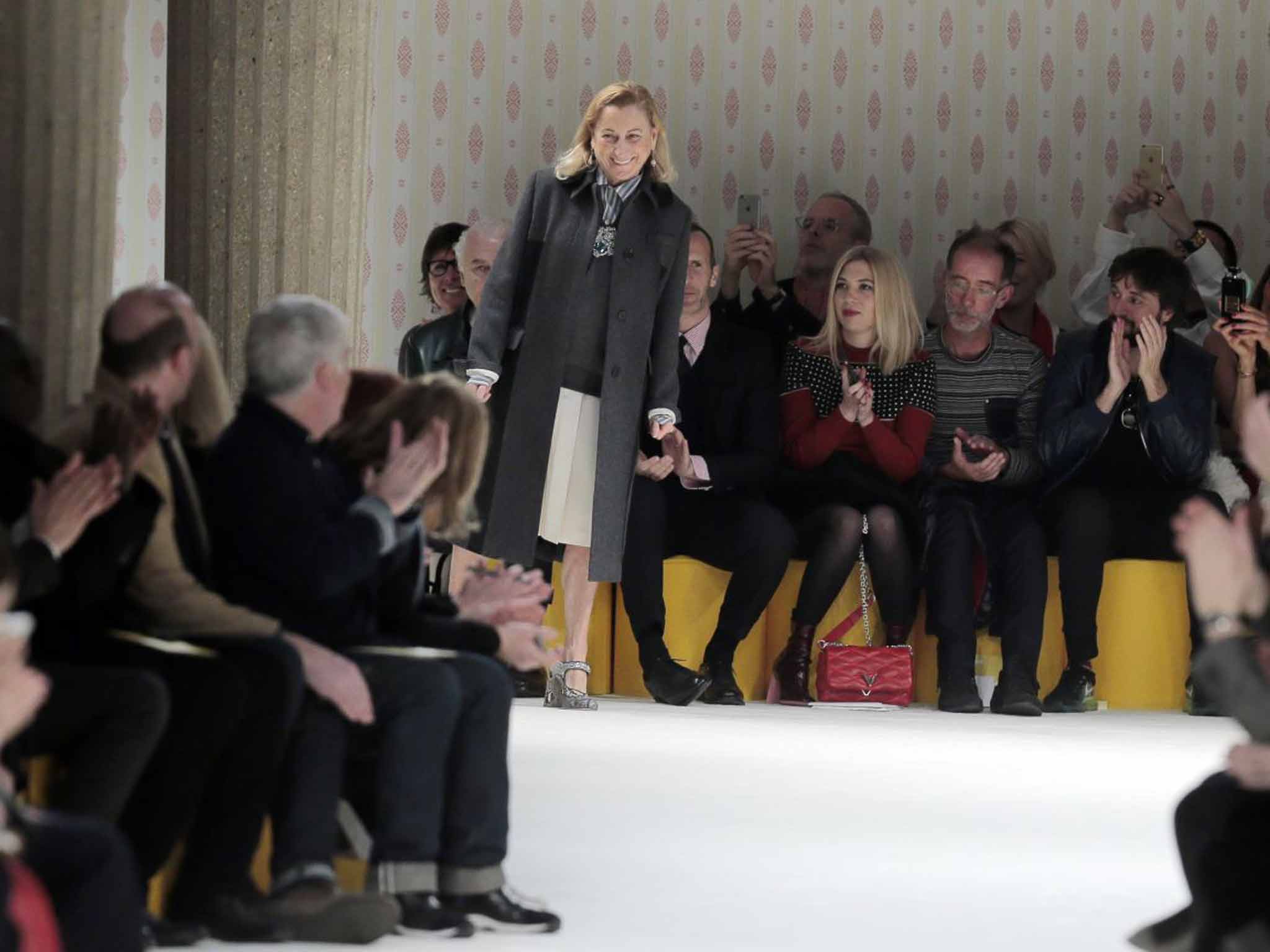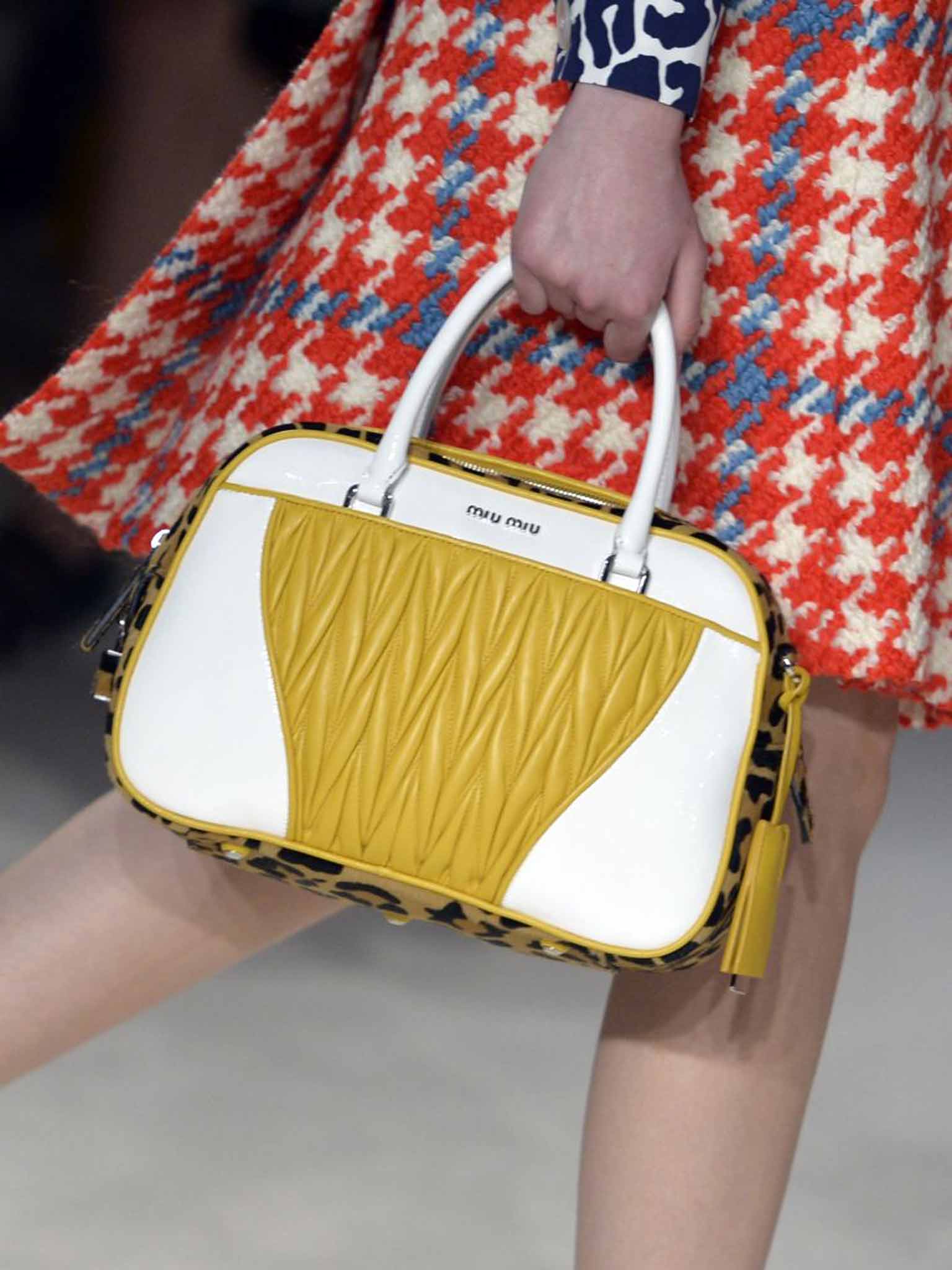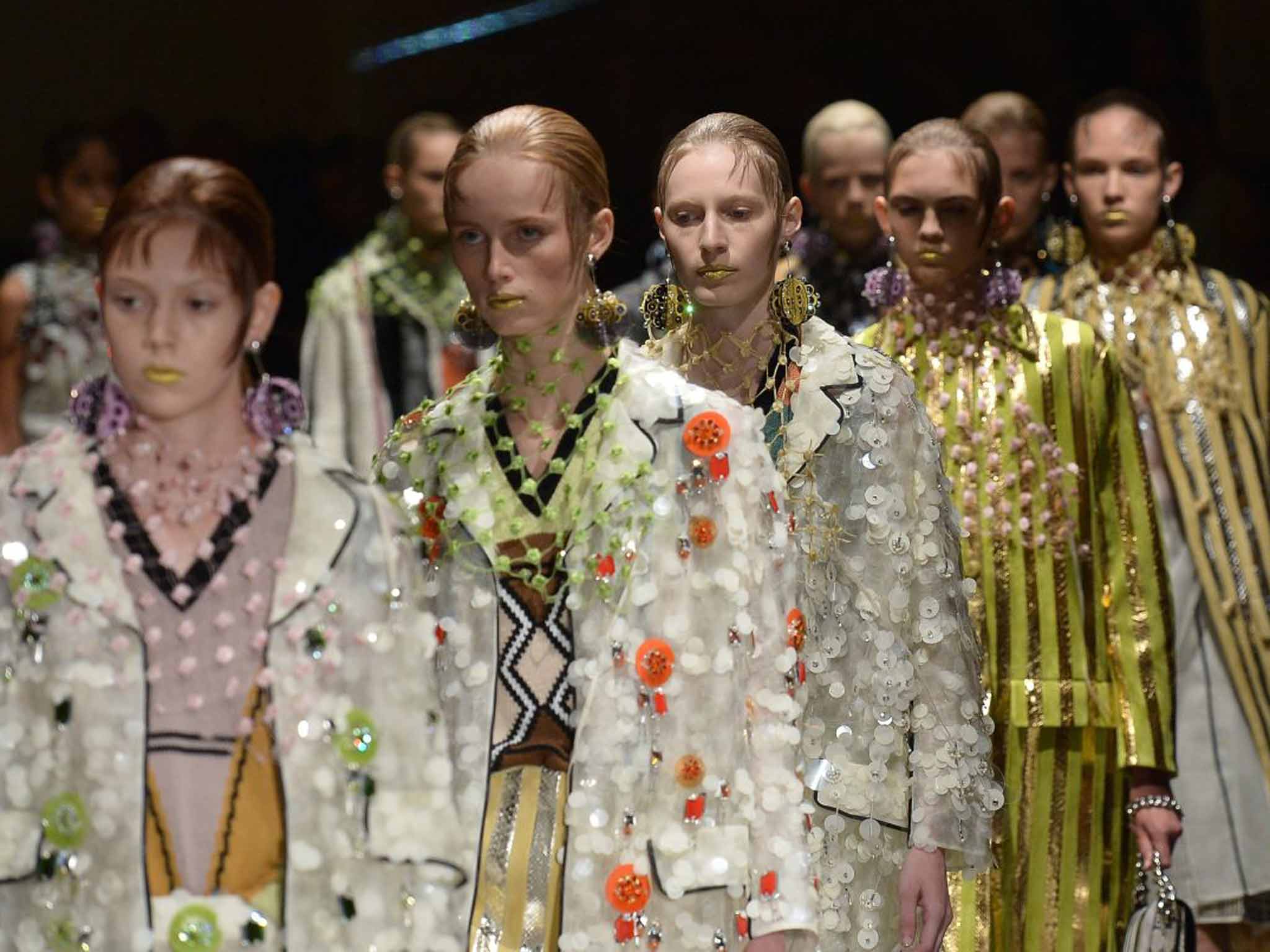Is Miuccia Prada the most powerful and influential designer in fashion?
By ignoring convention, Donna Miuccia Prada has become fashion's first lady, a crown she will claim again today in Milan. In a rare interview, she explains to Alexander Fury, The Independent's fashion editor, how she values substance over style

The architecture of Milan is a strange, senseless mess, a hotchpotch of classical and modernist, robust Renaissance palazzi and nineteenth-century homes jostling against Brutalist concrete edifices. Plenty of those were thrown up during “il boom,” the Italian economic miracle of the post-war years: handily, lots of old architecture had been blown up during Allied bombing, making ample space for shiny new factories and tower-blocks.
That architecture always reminds me of the collections of Miuccia Prada - probably because it’s not only in the back of my mind, but in the corner of my eyes, the four times a year I travel to the Via Foggazzaro in south east Milan to see how Mrs Prada will change the fashion world, again.
It reminds me of Prada because she, too, has a disregard for conventions of taste, for the constraints of history, for putting things in their proper place. She wildly thuds together old and new, beautiful and ugly. Her collections, both in themselves and in their chronological sequence, are alarming in their flagrant indifference to conventional rationale. She has always had this sense to her work.
Miuccia Prada is the most powerful designer in fashion, I think. She’s also the most influential, and the most copied. We meet not to talk facts, but ideas. You can crib the facts easily: she was born to a well-to-do Milanese family, with a luxury leather goods label - Fratelli Prada - that she inherited in 1978. She studied mime at the Teatro Piccolo, following a political science PhD at the University of Milan. She was a member of the Italian Communist party, where she picketed in Yves Saint Laurent. I read a fabulous quote where Mrs Prada said she thought beauty was ‘bourgeois,’ which seems like a good Communist quote. “Every young kid who was vaguely clever was Leftist,” she shrugs today. “So it’s not that I was so special.”

What was special was the love of fashion harboured by Miuccia - she was Miuccia back then, marrying her husband and now co-CEO Patrizio Bertelli in 1987. They had met a decade earlier at a trade fair, where Prada accused Bertelli of copying her company’s designs, but then teamed up with him. Her love of fashion, she said, was more clothes. “Fashion it was not the word. I always say it was the worst place for a Feminist in the sixties… Dressing myself, I always loved and still love and I think there’s nothing wrong with that. I always wanted to be the first to have everything, to look different from the others. It started at a very personal point.” In the eighties, before Mrs Prada presented her first collection in 1988, she wore vintage clothes, or clothes she bought in uniform outfitters. She hated everything else. “I don’t dislike I don’t reject… I don’t disown clothing,” she says. “I always accepted my love for clothes, but I didn’t want to enter into the fashion business. But I did it I think because I probably liked it. And the liking of doing it was more than the theoretical dislike.”
Plenty of profiles of Mrs Prada focus on what she is wearing, when she meets with a given journalist. Instead, I thought I’d talk about what I was wearing. That was largely nondescript, mostly black - the temperature outside Mrs Prada’s ferociously air-conditioned, clinically cool white office topped 38 degree centigrade, a hundred Farenheit. We meet in Milan, in July.
But anyway. I was carrying a black nylon Prada backpack. It wasn’t a sycophantic gesture; it is simply the bag I use everyday. Coincidentally, it’s also the bag Mrs Prada built her fashion empire on, released in 1984; fittingly, it’s also the bag that best summarises her inversion of long-held value systems, her destruction of centuries-old notions of luxury. Her fashion revolution. The Great Nylon Renunciation.
In the Renaissance, monarchs passed sumptuary laws in an attempt to restrict the conspicuous sporting of fine stuff deems suitable only for a tiny, aristocratic elite. They failed. Mrs Prada has succeeded. She’s got the fashion world in the bag.
We meet two weeks after Mrs Prada showed her Miu Miu resort collection in Paris (she show the next, for spring/summer 2016, this afternoon). She also launched the label’s first fragrance. If Prada is cerebral, deep and meaningful, Miu Miu is the light-hearted little sister, the line’s title drawn from Miuccia’s childhood nickname. It’s still intellectual, because that’s Mrs Prada’s approach to fashion (Incidentally, like a schoolteacher, she’s always referred to as Mrs Prada). But a different kind of intellect. It’s as influential as the mainline.
There’s a rumour I’ve heard that Miu Miu is designed in the twelve days between the Prada show and its presentation in Paris. I ask if this is true and Mrs Prada nods, emphatically. “When I work on Prada, we work for one month. Already there are so many ideas that maybe we don’t do for Prada, so I know. I say ‘Please, let’s spare something for Miu Miu!’”
For the July Paris show, it was, she says, a”mix” of Miu Miu ideas. It ended up like a greatest hits. Best-sellers, but twisted. Because, in the eyes of Miuccia Prada, a best-seller can be a bad thing. “A lot of my consideration is that, in a world that is getting bigger and bigger, the idea that people like less and less,” she comments. “That’s why the last shows were about animal prints, symbols - because that’s what people want. They want animal prints, pink bows. The list of what people like is more and more reductive. This is the problem of culture, I remember the polemic since the sixties, that museums are enlarging, enlarging culture, and people go to the Louvre eating ice cream, just looking at the Gioconda. Is it better?”
You don’t often hear fashion designers posing questions like that, but Mrs Prada doesn’t think like other fashion designers. The Gioconda reference is particularly telling because earlier this year Mrs Prada opened a museum, the Fondazione Prada, designed by OMA under the direction of Rem Koolhaas, to house the art institute she founded in 1995. She is friends with a number of artists, including Carsten Holler, who installed one of his trademark slides to shoot out from her office in central Milan; Francesco Vezzoli, who has painted her portrait numerous times; and Damien Hirst, with whom she once collaborated on a handbag. “Damien is a friend of mine… I said, ‘Listen, I don’t want to do a bag.’ So I did a bag that was so repulsive! It was so repulsive that no woman would put a hand on it!” Mrs Prada laughs. She isn’t a fan of fashion’s favourite cross-fertilisation of art and fashion: that’s the only direct crossover between in the Prada universe, the company at pains to emphasise the separation from the Fondazione and Prada S.p.A.
I wonder why. Mrs Prada smiles, and it’s a bit like the Gioconda. “This is the cleverest question you could ever ask me, because I ask it also to myself. I think because it’s the most obvious. And everybody does it. Because in theory, sincerely, there is no limit.” She pauses and drinks water. “The line is: I don’t want to do what the others do.”
My favourite word that Mrs Prada throws out, during our near-two hour conversation, is “disturbing”. Miuccia Prada likes to disturb. “When I started, everybody hated what I was doing except a few clever people,” she states, smiling widely. “Because it was not for the classic ones - there was something disturbing. And for the super trendy, avant-garde-ists, it was too classic. I always like to move in that space, never please anybody. There is always something disturbing, which is probably what I am, and I like.”

Looking at that first Prada collection today is a revelation, because its clothes - beaded wools, vibrant print, jackets with décolletage scooped low, a few clutched duster-coats and Italian Mama-style kick-skirted dresses - are part of the Prada cannon. You can recognise them in collection after collection over almost thirty years. “They thought it was in horrible taste,” Mrs Prada smiles again. “Still now, I think that a part - the more conservative part - of the fashion world think that they’ll stick with the idea of glamour and beauty that is so obvious, so old. Even now, it’s not so much different.”
But it is different, because Mrs Prada is fighting it, and her work has shifted the axes of fashion. She has transformed forever how we view the age-old ideas of taste and beauty - Prada added the paradoxical phase “Ugly Chic” to the fashion lexicon - and in turn their relationship to the clothing on our backs. “That is what is really interesting,” she says. “How people are perceived - what people relate to, what fascinates them, and how the fusion of fashion and culture makes people react.”
There is always a search, with Prada, for the new. The next. Not even the now - it’s looking further than that. “Too many times I don’t do something because somebody else did it,” states Mrs Prada, “because we want to be more original.”It’s something all fashion designers should be striving for, but in actual fact most don’t. They filch, instead, from Mrs Prada’s fertile imagination: she is, perhaps, the most copied designer in contemporary fashion. Coming out of the spring/summer 2016 shows, you see echoes of her work everywhere, with dozens of other labels sewn in. I ask if that bothers her and she shrugs again. “It’s very common.”
The common, the cliché, the banal. Those are words Mrs Prada iterates again and again, with a withering disdain. “The world tends towards banality,” she allows. She isn’t misanthropic: she’s simply arguing for another point of view. Of her clothing, she says “It’s against any cliché, for so many reasons. That, I never thought about. But I can run through the list. First of all it’s because there is the political side, which is rejecting that idea, because simply, it is wrong, it’s not dignified for women, so you have to be a doll to be beautiful, always the same. That’s why I hate bias cut, everything that people think make women beautiful. I’m against that, in principal from a personal and human point of view. The other reason I am against it, is because it is banal. I want to be more clever, or more difficult, or more complicated, or more interesting, or more new.”
Understandably, given the above, Prada is often characterised as an intellectual label - one for thinkers, sure, albeit also a commercial behemoth (Forbes valued it this year at over £10bn, with sales totalling £3bn). Mrs Prada is clever, sure: but in person she isn’t dry or humourless or pontificating, as that label suggests. Neither are her clothes. “It’s not so wrong that I protest,” she says when I ask her how she feels about the moniker. “But at the same time that cliché means that you’re boring, that you’re serious, that I hate! So probably after a comment like that, I want to do a show that is so stupid. Be queen of the stupid!”
She didn’t, of course. Because Prada can’t really do stupid. “Always when I work I always say, yes its beautiful - but who cares? What is the reason? First of all, it has to be a concept. And after, when I get to the concept, very often I will say ‘Oh, let’s go home!’ Because for me, the work is done. But the transformation of the concept to the reality, that’s the tough part. Also kind of boring, but difficult. You say ok, the dress should represent that idea, but how can we do it? Represent that idea? For me it’s easier because when I get to the concept, I relax. But after, to translate the concept into reality is much more boring. But where you really learn more. Translating an idea to reality. That’s probably the most difficult part.”
Most of the fashion world doesn’t concern itself with complicated ideas like Prada’s: when her ideas are copies, it’s the visual manifestation we get rehashed, not the intellectual rigour. Stuff like crinkly dresses trussed up with ribbon and split down the back, or short sixties looks splodged with Art Nouveau flowers in a bracken palette of olive and bruise purple. They look attractive and engaging enough still, but there’s nothing beyond the surface. Which you could take away from the Prada originals too. I doubt the throngs of tourists that crowd into the tiny, original Fratelli Prada store in Milan’s Galleria Vittorio Emanuele II, a baroque shopping precinct of vaulted ceilings and mosaic floors, are fully engaged with Miuccia’s musings on contemporary femininity and culture.
Mrs Prada isn’t overly bothered. “I like to do something so the front, what appears… is attractive and easy. But after, depending on the culture or the sophistication of people, they often feel something else,” says she. Like a Trojan Horse, Miuccia Prada uses her fashion as the vehicle for ideas. “The sophisticated person looks at everything,” she comments. “Someone who is superficial gets only the façade.”
The quotes for this article also appear in Alexander Fury's Q&A interview with Miuccia Prada in the latest issue of 'Document Journal' magazine, guest edited by Olivier Rizzo, on sale tomorrow documentjournal.com
Join our commenting forum
Join thought-provoking conversations, follow other Independent readers and see their replies
Comments